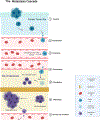Modeling metastasis in mice: a closer look
- PMID: 34303648
- PMCID: PMC8906831
- DOI: 10.1016/j.trecan.2021.06.010
Modeling metastasis in mice: a closer look
Abstract
Unraveling the multifaceted cellular and physiological processes associated with metastasis is best achieved by using in vivo models that recapitulate the requisite tumor cell-intrinsic and -extrinsic mechanisms at the organismal level. We discuss the current status of mouse models of metastasis. We consider how mouse models can refine our understanding of the underlying biological and molecular processes that promote metastasis, and we envisage how the application of new technologies will further enhance investigations of metastasis at single-cell resolution in the context of the whole organism. Our view is that investigations based on state-of-the-art mouse models can propel a holistic understanding of the biology of metastasis, which will ultimately lead to the discovery of new therapeutic opportunities.
Keywords: genetically engineered mouse models (GEMMs); metastasis; syngeneic models; xenograft models.
Copyright © 2021 Elsevier Inc. All rights reserved.
Conflict of interest statement
Declaration of interests The authors declare no conflicts of interest.
Figures


References
-
- Nguyen DX et al. (2009) Metastasis: from dissemination to organ-specific colonization. Nat Rev Cancer 9 (4), 274–84. - PubMed
-
- Dongre A and Weinberg RA (2019) New insights into the mechanisms of epithelial-mesenchymal transition and implications for cancer. Nat Rev Mol Cell Biol 20 (2), 69–84. - PubMed
-
- Pastushenko I et al. (2018) Identification of the tumour transition states occurring during EMT. Nature 556 (7702), 463–468. - PubMed
Publication types
MeSH terms
Grants and funding
LinkOut - more resources
Full Text Sources
Medical

